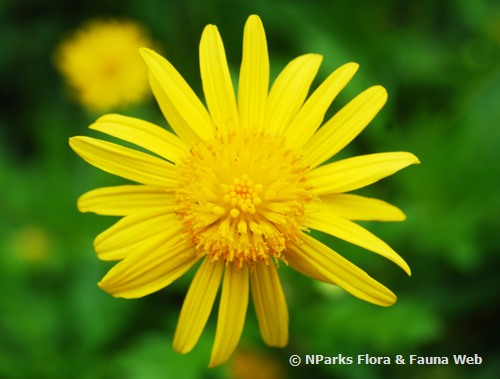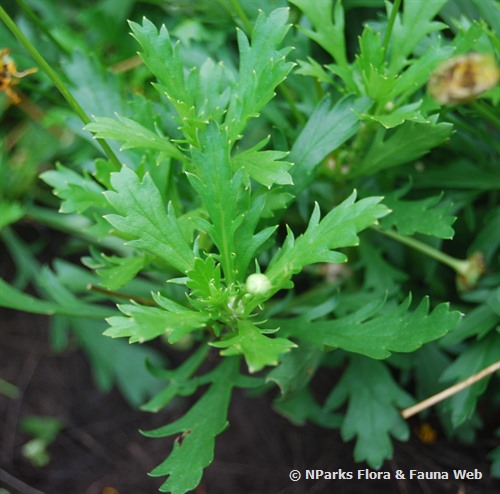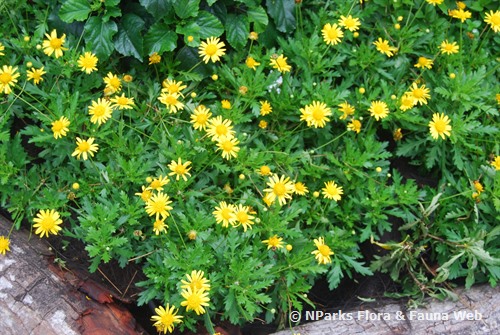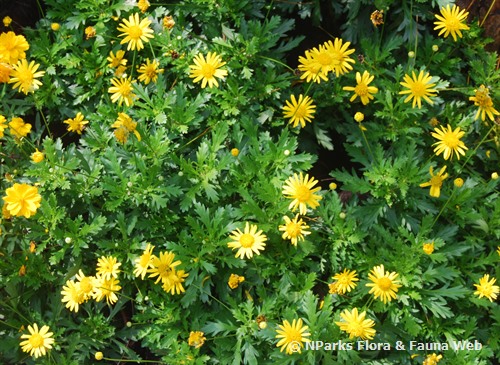
Back
Euryops pectinatus 'Viridis'
| Family Name: | Asteraceae (Compositae) |
| Common Name: | African Daisy, Golden Euryops, Golden Daisy Bush |
Name
Classifications and Characteristics
| Plant Division | Angiosperms (Flowering Seed Plants) (Dicotyledon) |
|---|---|
| Plant Growth Form | Shrub |
| Lifespan (in Singapore) | Perennial |
| Mode of Nutrition | Autotrophic |
| Plant Shape | Rounded, Shrubby |
| Maximum Height | 0.9 m to 1.8 m |
| Maximum Plant Spread / Crown Width | 0.9 m to 1.8 m |
Biogeography
| Native Distribution | Of horticultural origin |
|---|---|
| Preferred Climate Zone | Sub-Tropical / Monsoonal, Mediterranean |
| Local Conservation Status | Non-native |
Description and Ethnobotany
| Growth Form | Round shrub up to 1.8 m tall. |
|---|---|
| Foliage | Finely dissected, feathery leaves are smooth and green (4-10 cm long). |
| Flowers | Bright yellow, daisy-like flowers (5 cm wide) are borne on long floral stalks (7-10 cm long) that extend above the foliage. They are solitary or occur in clusters. Flowers are produced throughout the year. |
| Fruit | The one-seeded fruits are known as achenes. |
| Others - Plant Morphology | The 'Viridis' cultivar has smooth, green leaves while the species Euryops pectinatus has grey, hairy leaves. |
| Habitat | The species Euryops pectinatus is endemic to the Cape in South Africa and found on rocky slopes. |
| Similar | The flowers look like daisies. |
| Cultivation | This fast-growing cultivar requires well-drained soil and full sun to flower well. Remove the spent blooms to promote continuous flowering. Once a year, cut off the top one-third of the plant to help it maintain a compact shape. Every few years, cut the plant back hard, leaving 15-30 cm above the soil. |
| Etymology | The genus Euryops means large eye in Greek, referring to the flowers, while the specific epithet pectinatus is Latin for comb-like, likely referring to its leaf shape. |
Landscaping Features
| Desirable Plant Features | Ornamental Flowers |
|---|---|
| Landscape Uses | Coastal, Beachfront / Shoreline, Groundcover |
| Thematic Landscaping | Golden Garden |
Fauna, Pollination and Dispersal
| Fauna Pollination Dispersal Associated Fauna | Butterfly-Attracting |
|---|---|
| Pollination Method(s) | Biotic (Fauna) |
Plant Care and Propagation
| Light Preference | Full Sun |
|---|---|
| Water Preference | Moderate Water, Little Water |
| Plant Growth Rate | Fast |
| Rootzone Tolerance | Drought Tolerant, Well-Drained Soils, Saline Soils / Salt Spray |
| Propagation Method | Seed, Stem Cutting |
Foliar
| Foliage Retention | Evergreen |
|---|---|
| Mature Foliage Colour(s) | Green |
| Mature Foliage Texture(s) | Smooth |
| Prominent Young Flush Colour(s) | Green |
| Young Flush Texture(s) | Smooth |
| Foliar Type | Simple / Unifoliate |
| Foliar Arrangement Along Stem | Spiral |
| Foliar Attachment to Stem | Petiolate |
| Foliar Shape(s) | Non-Palm Foliage |
| Foliar Venation | Pinnate / Net |
| Foliar Margin | Pinnately Lobed / Pinnatifid |
| Foliar Apex - Tip | Acute |
Floral (Angiosperm)
| Flower & Plant Sexuality | Unisexual & Bisexual Flowers(Sub-dioecious) |
| Flower Colour(s) | Yellow / Golden |
|---|---|
| Flower Grouping | Solitary, Cluster / Inflorescence |
| Flower Location | Terminal |
| Flower Symmetry | Asymmetrical |
| Individual Flower Shape | Ligulate / Strap-shaped |
| Inflorescence Type | Compound Head / Capitulum |
| Flowering Period | Free-Flowering |
| Flower Lifespan on Plant | Several Days |
| Flower Size | 5 mm |
Fruit, Seed and Spore
| Mature Fruit Texture(s) | Smooth, Bristly |
|---|---|
| Fruit Classification | Simple Fruit |
| Fruit Type | Indehiscent Dry Fruit , Cypsela |
Image Repository
Others
| Master ID | 33785 |
|---|---|
| Species ID | 8201 |
| Flora Disclaimer | The information in this website has been compiled from reliable sources, such as reference works on medicinal plants. It is not a substitute for medical advice or treatment and NParks does not purport to provide any medical advice. Readers should always consult his/her physician before using or consuming a plant for medicinal purposes. |



